New Book Releases / Winter 2021
If you would like to alert us to a recent or forthcoming film publication for the next round-up in winter, please contact us here. For notes on more books, see David Hudson’s monthly roundup at Criterion’s The Daily.
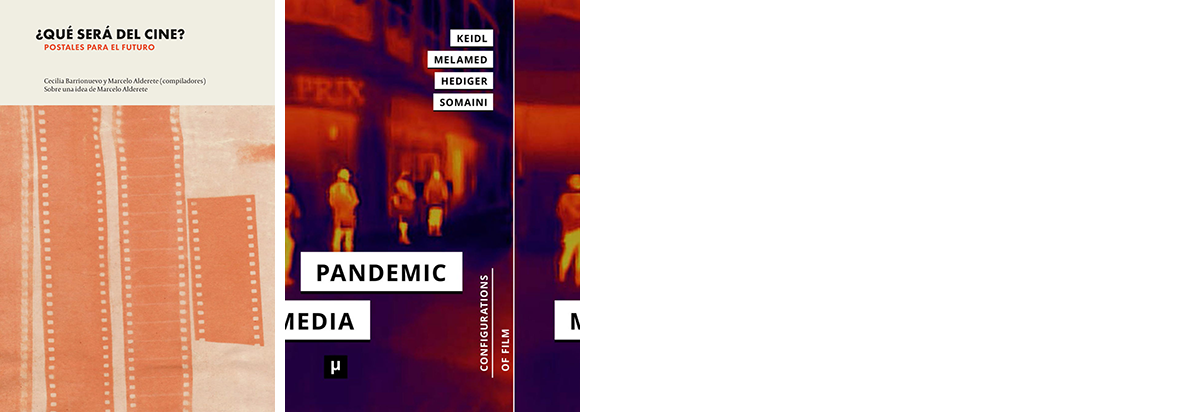
As promised, we're back fairly early with a winter round-up of recent or forthcoming film books. It's the perfect time for looking back and looking ahead, just what the first set of eight publications is doing. In case you missed it, the Mar del Plata film festival published a free collection, What Will Become of Cinema? Postcards for the Future. It gathers more than seventy texts about the future of cinema. Among the filmmakers, actors, programmers and critics who contributed their reflections, you can find Claire Atherton, Nicole Brenez, Cíntia Gil, Roger Koza, Mariano Llinás, Adrian Martin, Olaf Möller, Matías Piñeiro, Angela Schanelec, Kidlat Tahimik, and many others. This Spanish-language book can be downloaded for free in the ‘Publications’ section of the festival website.
Another open access collection, Pandemic Media: Preliminary Notes Towards an Inventory, brings together a series of 37 flashlight essays (hence the subtitle) which try to offer a glimpse of some of the challenges to come. It includes contributions on topics such as streaming the film library, the 2020 resurgence of the marginal ‘dispositif’ of drive-in theaters, the film festival ecosystem in pandemic times, the reconfiguration of the close-up and the everyday split-screen aesthetics of our 'Zoomified' existence. The book’s cover is based on the current work of Magnum photographer Antoine D’Agata, who has been documenting the impact of the pandemic in Paris streets and hospitals with a heat sensor camera. The publication comes out of the research program ‘Configurations of Film’ at Goethe University in Frankfurt. It's the latest volume in their book series published by the new Meson Press, where the full publication can be accessed. An ePub and print edition should be available soon.
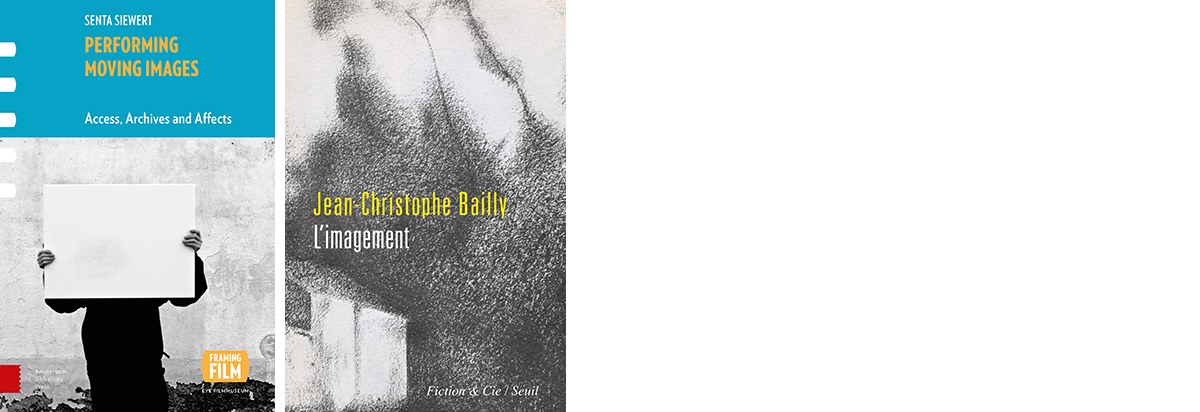
Performing Moving Images: Access, Archive and Affects presents some of the institutions, engaged individuals and networks that in recent years have worked to ensure that experimental cinema and artists' films of the 1960s and 1970s continue to be screened rather than be consigned to oblivion. In the book, Senta Siewert discusses an interesting range of recent international case studies from festivals, museums, and gallery spaces, such as Arsenal and Forum Expanded in Berlin, the Oberhausen short film festival, Anthology Film Archives, LUX, Light Industry, Lightcone and EYE. The study asks: what is the relationship between an aesthetic experience and memory at the point where film archives, cinema, and exhibition practices intersect? How does the affective experience of this resonate today? You can order the book and find the introduction and table of contents on the website of Amsterdam University Press.
The affective focus of the latter book connects with an earlier book of 2020, L'Imagement by the French art critic and philosopher Jean-Christophe Bailly. In a collection of thirteen texts, he explores the force with which an image, in front of us, remembers, and the force with which it asks us to identify what it is the memory of. “Every image is a haunted house, every house is haunted by images,” Bailly writes. Starring Georges Seurat's crayon drawing La maison hantée on its cover, the investigation spans all eras of art and explores different modes of image-making (be it painting, the drawings of Nicolas Poussin or a series of photographs by Walker Evans). You can read the introduction and order the book on the website of publishing house Seuil.
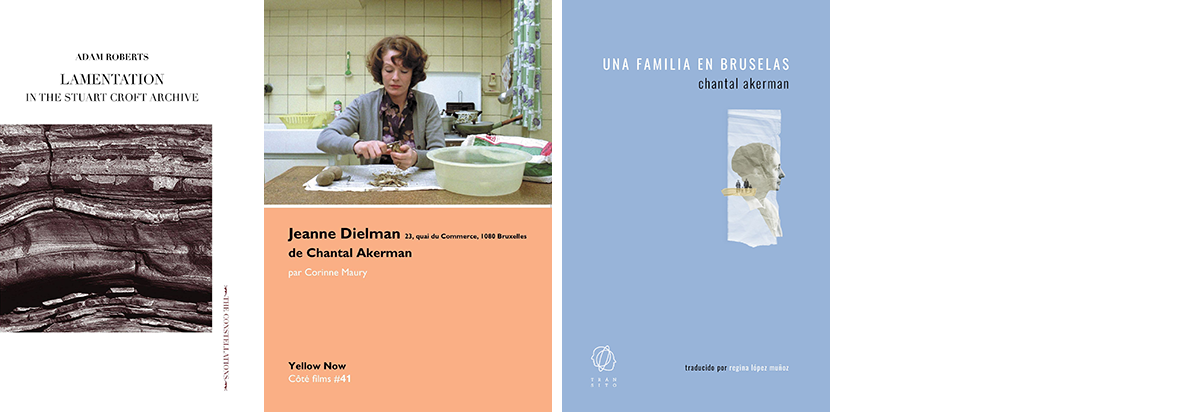
Lamentation: In The Stuart Croft Archive begins in the archive, examining the legacy of the British artist filmmaker Stuart Croft (1970-2015) whose life and work was cut short unexpectedly. Adam Roberts – curator, filmmaker and co-founder of the A Nos Amours collective – accounts for his visits to examine Croft's archival records held at the BFI National Archives, and the experiences he had while doing this work. Much more than a book on Stuart Croft, Lamentation offers a thought-provoking meditation on grief, mourning, the archive, and our collective responsibility in addressing our past and caring for our future. Adam Roberts asks what remains beyond a person’s death and how we can make present what has been lost. He writes profoundly and personally about loss, remembrance, and the fragility of human existence, as scholar Marion Schmid puts it so nicely on the website of publisher Ma Bibliothèque where you can order a copy for only 9 pounds.
Lamentation interweaves the memories of Stuart Croft with reflections on the death of another artist who left us too young, Chantal Akerman. Last October, Corinne Maury's book-length essay on Akerman's magnum opus, Jeanne Dielman. 23, quai du commerce, 1080 Bruxelles (1975), has been published with Editions Yellow Now. The writing of this essay was guided in part by the original script of the film. Fragments of the typescript lead, enlighten and constitute the analysis of the film along with other facets of the work. It's the 41st volume in the publisher's ‘Côté Films’ series that's supervised by Marcos Uzal and dedicated to monographs on one film. You can find the table of contents and order the book on their website. We'd also like to note here that Akerman's book Une famille à Bruxelles (L'Arche, 1998) has been translated to Spanish for the first time and is available through the website of Editorial Tránsito since mid-January.
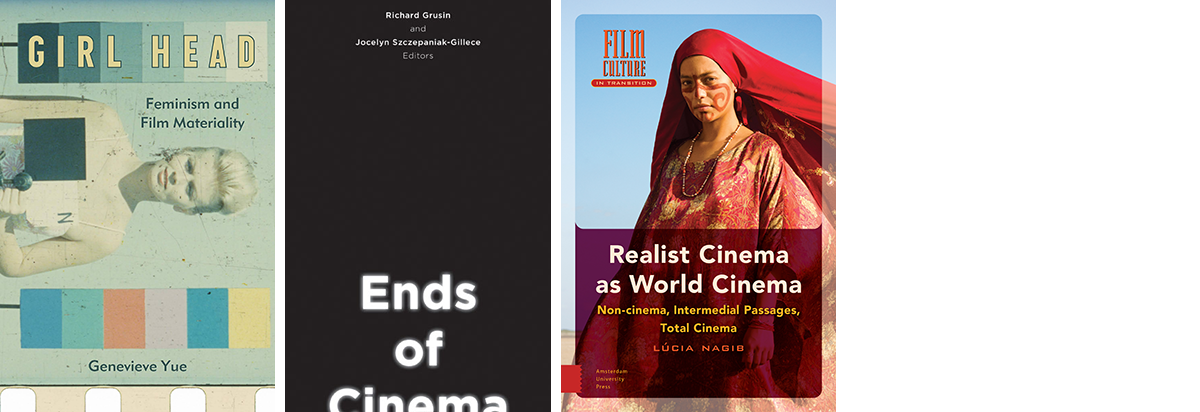
To pick up again and almost round off this cluster on archives, Girl Head: Feminism and Film Materiality shifts the feminist focus from issues of representation – the film just mentioned above has often been a prime case of this – to the role of gender in film production processes and the material object underlying the images. In rich archival and technical detail, the author examines three sites of technical film production: the film laboratory, editing practices, and the film archive. Genevieve Yue teaches at The New School in New York and is a contributor to October, Reverse Shot, Artforum and Film Comment. You can read a sample, find the table of contents and order the book on the website of Fordham University Press.
At the tail end of a challenging year for movie theaters and film as an art form, came a book titled Ends of Cinema. While we opened with a collection of postcards for the future, this volume deals with multiple “ends” in the history of cinema and reinvigorates this debate to contemplate the ends, as well as directions and new beginnings, of cinema in the twenty-first century. Leading scholars such as Francesco Casetti and Mary Ann Doane take a spatial approach to the question, while André Gaudreault contemplates the ways in which language configures the subject. You can find the table of contents and purchase the book on the website of the University of Minnesota Press.
Correspondingly, the opening chapter of the next book is called “The Death of (a) Cinema”. In it, Wim Wenders’s 1982 Der Stand der Dinge [The State of Things] is analyzed as an attempt to theorise, in form and content, a cinematic end of history by means of the disruption of the film within the film they were working on. For author Lúcia Nagib, it's a foundational classic for the first of her three categories of ‘realist modes of production’ that structure her new book, Realist Cinema as World Cinema, because the film distills the idea of 'non-cinema', or a cinema that aspires to be life itself. The other two categories she proposes are ‘intermedial passages’, or films that incorporate other artforms as a channel to historical and political reality; and ‘total cinema’, or films moved by a totalising impulse. The (sub)title can definitely confuse, but it's first and foremost a book about realism in cinema. Its thesis is that ‘world cinema’ could be advantageously replaced with ‘realist cinema’, understood here by the way films are made. You can download the full open access edition for free or buy a physical copy on the website of Amsterdam University Press. Last December, the news came that the ‘Film Culture in Transition’ series – of which this book is part of – got a new editorship appointed to ensure the continuation of the mission of the late Thomas Elsaesser who founded this collection.
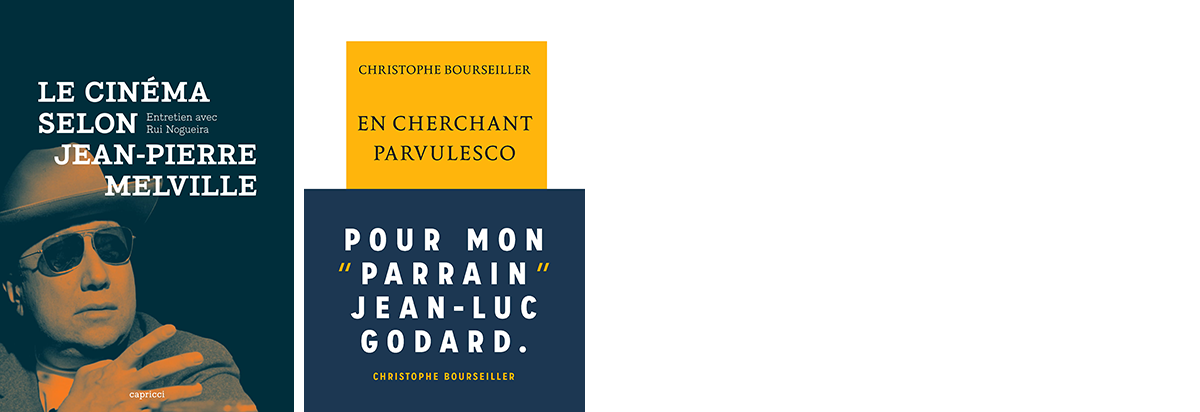
Let's move on to our usual overview of publications focussed on a single filmmaker. Just out this month, Le cinéma selon Jean-Pierre Melville is a new edition of this classic interview book with the French filmmaker by Rui Nogueira, critic and former collaborator of Henri Langlois at the Cinémathèque française. Originally published as Melville on Melville (Secker and Warburg/BFI, 1971) and first translated to French in 1973 (Seghers), this reissue of one of the first and best books on the director is now updated with an unpublished chapter on Le chagrin et la pitié by Marcel Ophuls, which marked Melville when it was released in 1971, as well as with a new afterword by Rui Nogueira himself. In this interview book, the filmmaker generously reflects on his career and the genesis of his films. He discusses his influences, his experience of the Second World War, the major themes of his work and his work as a director. Little by little a complex and sometimes contradictory personality emerges: the portrait of a secretive and proud man, renowned for his quarrels and his anger, but carried by an unconditional love of cinema. You can find the table of contents, read an excerpt and order the publication on the website of Capricci.
In the book (and the excerpt), you can read Jean-Pierre Meville on his famous cameo in Jean-Luc Godard's A bout de souffle (1960) as the novelist Mr. Pavulesco. Godard gave the name of this Romanian writer to Melville's character, but not much is known about Jean Parvulesco (1929-2010). Now a book has been written about him by Christophe Bourseiller, a friend of Godard who popped up in Deux ou trois choses que je sais d'elle (1967) and other of his films and is the son of theatre director Antoine Bourseiller, historian of Situationism, punk and other cultural movements. Taking up half of the cover in a larger text size than the actual title, the author dedicated the book to his “godfather” Jean-Luc Godard. Critic Adrian Martin noted that Parvulesco was one of the most fascinating figures to emerge from Antoine de Baecque and Noël Herpe's recent Éric Rohmer biography as an important ‘semi-clandestine’ figure (tied in with a certain right-wing mysticism) involved with several of the Nouvelle Vague directors, over quite a long period (Rohmer literally helped support him to the end of his days), and who later went on to write more than fifty books (some published with the aid of critic Michel Mourlet). And in his time in Spain in the early '60s, Parvulesco published several articles hailing the Nouvelle Vague as a great and important “fascist” movement... Curious what more will come out when En cherchant Parvulesco is available on February 4. You can order the book through the website of publisher La Table Ronde.
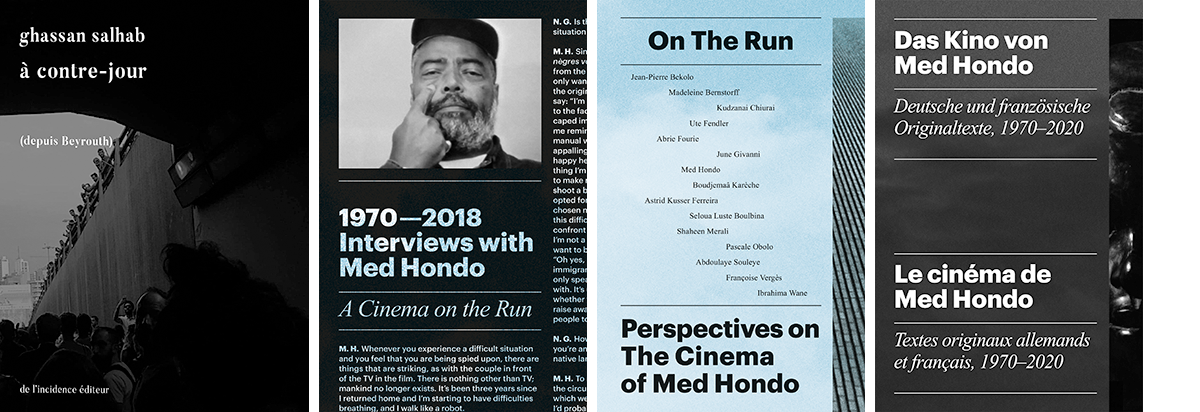
Next up are two ‘political’ directors and activists. Forthcoming on February 19, À contre-jour (depuis Beyrouth) brings together several texts by the Dakar-born, Lebanese filmmaker Ghassan Salhab devoted to the political situation in his home country since the demonstrations of October 17, 2019, the consequences of which continue today. Mostly published on Lebanese news sites or in French newspapers, these short texts with calls for uprising and the continuation of protests against the government – marked by a poetic, unresigned tone – trace with determination the life of the Lebanese movement for a year. They are accompanied by about fifty of Salhab's photographs of his participation in the movement and daily life in Beirut. Taken in the streets, among the demonstrators, they come to constitute a portrait of the crowds and of the Lebanese city. You can order the book on the website of De L’Incidence Éditeur.
Last December, Berlin’s Archive Books presented an impressive three-part publication project on the French-Mauritanian filmmaker Med Hondo (Soleil Ô, 1967). The first volume, 1970-2018 Interviews with Med Hondo, brings together seventeen interviews conducted with him over a period of almost half a century. Most of them were originally published in French and translated into English, such as the 1970 interview by Guy Hennebelle that you can read on Sabzian. The second tome, On the Run: Perspectives on the Cinema of Med Hondo, features contributions that pay tribute to his films in highly contrasting ways. The third publication of this series, Das Kino von Med Hondo / Le cinéma de Med Hondo, consists of twenty-two essays and interviews in French and German – texts that are part of the first two books and appear in this volume in their original language. This publication only exists in digital form. The e-book can be downloaded for free on the website of the publishing house because they deem it “important for these texts to exist in their original form so that they may activate discussions about Hondo′s work that is only now slowly gaining recognition in countries such as Germany.”
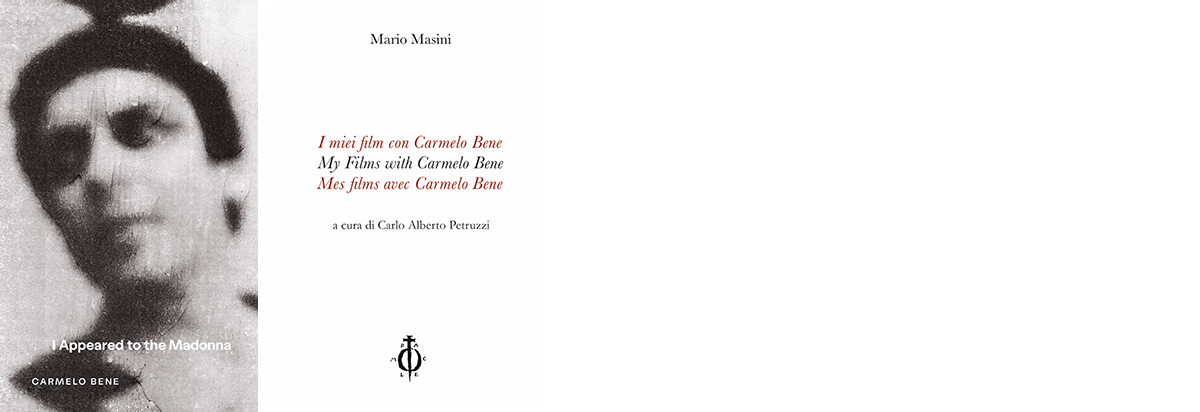
There has been a wave of worthwile books on Italian and Portuguese filmmakers. We dedicate a subsection to each. Similar to Archive Books with their work of Med Hondo, Contra Mundum Press embarked on a multi-volume translation project to share the work of avant-garde film and theatre director Carmelo Bene (1937–2002) with Anglophone readers. They've started with the translation of his 1983 autobiography I Appeared to the Madonna [Sono apparso alla Madonna]. Less factual autobiography and more autobiographical poem, the book is a kind of ars poetica and chronicle of his life, self-described as very risky, imaginary, and at the same time real. Founded on Bene’s concepts of non-being, this testament of Bene’s life includes tales of his combative encounters with critics, the public, and his iconoclastic views on theater, cinema, poetry and more. The autobiography is preceded by the introduction he wrote for his collected works published by Bompiani in 1995 and titled “An Autographical Portrait” [“Autografia di un ritratto”]. You can read a sample, find the table of contents, and order the book on the website of Contra Mundum Press.
Forthcoming translations will comprise the prose works Bene included in his collected works. One such volume will present the novel Our Lady of the Turks (1966). Another volume will include a collection of Bene’s shorter prose pieces and a work for the stage, his version of De Musset’s armchair play Lorenzaccio (1986), excerpts from The Voice of Narcissus (1982), a fascinating collection of reflections on theater that Bene chose to include in his collected works; and lastly, a piece entitled “Theatrical Research in the Representation of the State, or on the Ghost’s Performance Before and After C.B.” (1990), which excerpts sections of Bene's book La ricerca impossibile [Impossible Research]. An eventual volume comprising a selection of Bene’s plays is also envisioned.
The release of this first volume in a series of translations of Bene’s writings coincided with the publication of My Films with Carmelo Bene / Mes films avec Carmelo Bene / I miei film con Carmelo Bene, the trilingual memoirs of his cinematographer, Mario Masini, who looks back on their collaboration. Although Masini also shot films for the Taviani brothers (Padre padrone, 1977), Haile Gerima and others, he's mostly associated with the filmmaker he made four films with. Consisting of a long interview with Masini and previously unseen iconographic material, the book is available on the website of Edizioni Damocle. You can read a combined review of the memoirs and autobiography in Cinema Scope.
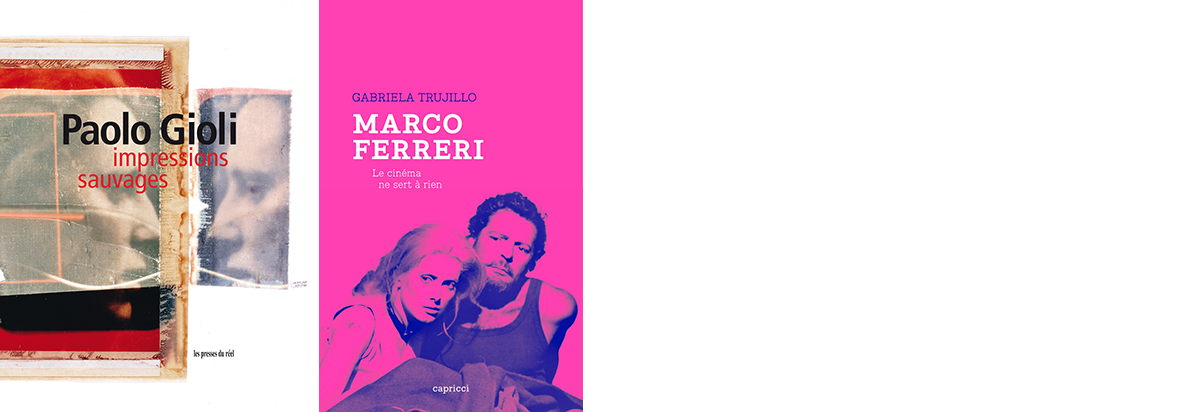
Another active member of the Italian avant-garde of the 1970s, photographer and filmmaker Paolo Gioli (1942), is celebrated with a retrospective monograph that offers an overview of his work, with a dozen essays, an interview and the artist's writings. David Bordwell has introduced Gioli as a craftsman who “has made films without cameras. He has devised his own cameras, often without lenses or shutters or motor drives. When he needs a shutter, his fingers, or perhaps some leaves from trees, will suffice. He has embedded images within images without benefit of optical printers, and he has brought photos to frenetic life without animation stands. (...) Impresario of clamps and masking tape, he creates extraordinary films with equipment that looks distinctly knocked-together.” In 2015, Gioli represented his country at the Venice Biennale and his works are part of the collections of the Centre Pompidou and MoMA among many others. You can find the table of contents and order Paolo Gioli: Impressions sauvages on the website of Les presses du réel.
Published this month, Marco Ferreri: Le cinéma ne sert à rien is the first book in French devoted to Marco Ferreri's complete body of work, beyond the scandal of La grande bouffe (1973), that sheds light on one of the most original, radical, elusive and underestimated figures of Italian cinema. In her end-of-the-year-list for Desistfilm, Nicole Brenez singled out this pubication as “a necessary book”. You can read an excerpt that contains the table of contents, and order the book on the website of the French publishing house named after the 1969 Carmelo Bene film, Capricci.
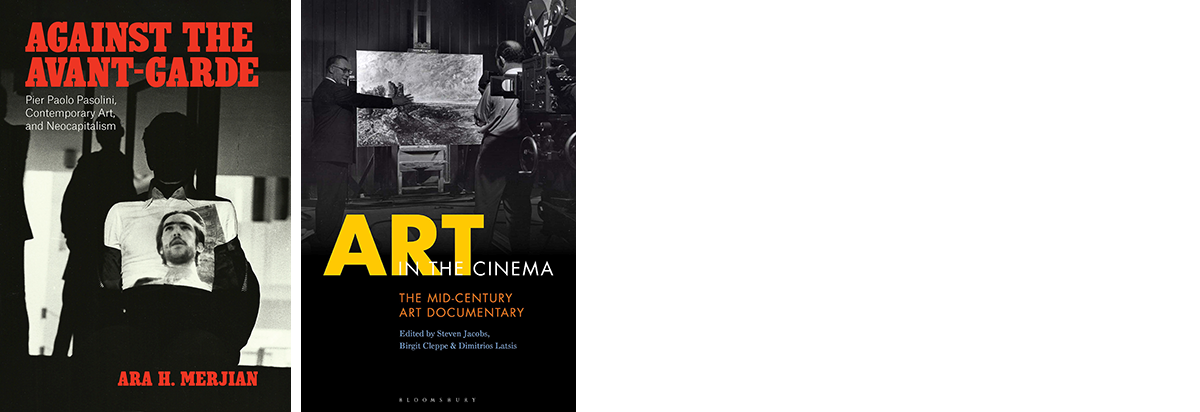
With Carmelo Bene acting in Edipo re (1967) and Marco Ferreri in Porcile (1969), we're almost automatically led to the filmmaker who in those years called the former a benchmark of avant-garde sensibility, as the author of the next book noted elsewhere. Art historian Ara H. Merjian's Against the Avant-Garde: Pier Paolo Pasolini, Contemporary Art, And Neocapitalism digs into Pasolini’s fraught relationship to the art scene of his own age and his hostility to the avant-garde, as he rather favored an approach through early-Renaissance painting which he studied with specialist Roberto Longhi at the University of Bologna. This interdisciplinarity study examines the many apparent paradoxes of Pasolini's beliefs and practices through case studies from the 1960s and 1970s, concluding with a reflection on Pasolini’s far-reaching influence on post-1970s art. You can find the table of contents and order the publication on the website of the University of Chicago Press.
In Merjian's book, painting serves as a key to understanding Pasolini's work as a whole. In Art in the Cinema: The Mid-Century Art Documentary, Steven Jacobs and Joséphine Vandekerckhove note that, “in the 1940s and 1950s, prominent art historians such as [the above-mentioned] Roberto Longhi (...) showed an outspoken interest in art documentaries. Occasionally, they were also involved in the production of such films. For these art historians, cinema was not only capable of bringing art to wider audiences, it also made it possible to compare, analyse and investigate artworks in original ways. Art documentaries, consequently, became tools of the art historian, generating new art historical methods and paradigms.” The book – edited by Dimitrios Latsis and the Belgian film and art scholars Steven Jacobs and Birgit Cleppe – digs in 'the Golden Age' of the art documentary, once a non-didactic, avant-garde film genre in its 1940s and 50s heyday. The volume contains contributions on little researched films such as Rubens (Paul Hasaerts & Henri Storck, 1948) or André Bazin's film on the Romanesque churches of the Saintonge district in France. The foundations of this book go back to symposia and film programs in KASKcinema in Ghent, Belgium in 2013 and 2017. You can find the table of contents and order the book on the website of Bloomsbury.
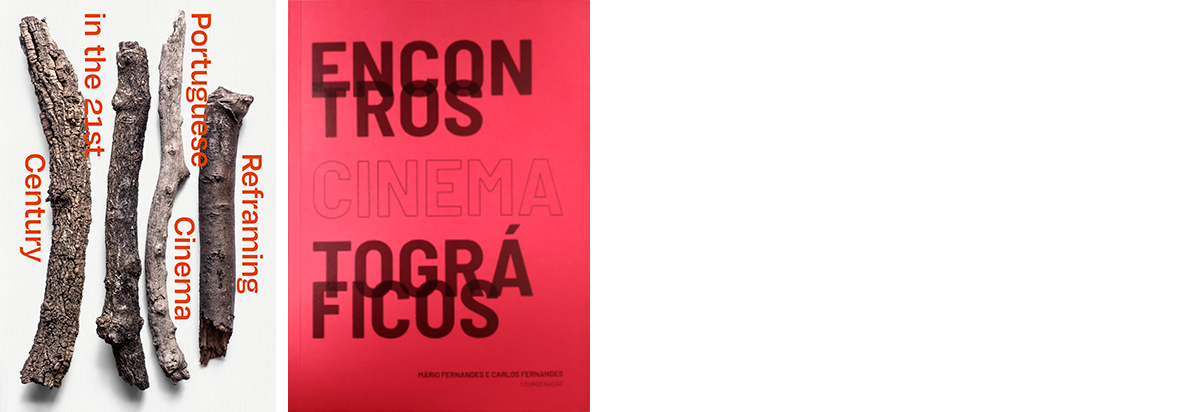
Time to proceed to the subsection on Portuguese cinema. Celebrating the 20th anniversary of the Portuguese Short Film Agency, Reframing Portuguese Cinema in the 21st Century is a work that analyses trends, transformations and filmmakers in Portuguese cinema of the last two decades. This publication is also available in an English-language version and features a stellar line-up of contributors including Adrian Martin, Carmen Gray, Cíntia Gil, Haden Guest, Leo Goldsmith and Roger Koza. They discuss filmmakers such as Pedro Costa, Miguel Gomes, João Pedro Rodrigues, João Rui Guerra DaMata, Filipa César, Salomé Lamas, João Nicolau, Susana De Sousa Dias, Pedro Pinho, Manuel Mozos, Teresa Villaverde and Gabriel Abrantes. You can order the book in the store of the publisher.
Encontros Cinematográficos is another collection with ten years worth of texts and interviews from the annual ‘Encontros Cinematográficos’ convocation in the Portuguese town of Fundão. One decade of encounters, camaraderie, love and affection for cinema, held in the city that sleeps in the shadow of the Gardunha mountains. An improbable place for cinematographic encounters, as improbable as were many of the encounters between filmmakers, critics, cinephiles and artists. More than a document for future memories, for students, cinema researchers or cinephiles, this Portuguese-language book embodies in letters the pleasure of discovering the work of original, fundamental, canonically misaligned filmmakers. It compiles contributions from Boris Lehman, Mieriën Coppens, Andy Rector & Billy Woodberry, Chris Fujirawa, Joaquim Pinto, João Bénard da Costa, Manuel Mozos, Marta Mateus, Michael Cimino, Ricardo Matos Cabo, Rita Azevedo Gomes, Victor Erice, Michael Guarneri, Patrick Holzapfel, Peter Nestler, Stefan Ramstedt, Tag Gallagher, and many others. This big red book is available in the bookshop of the Cinemateca Portuguesa, Linha de Sombra.
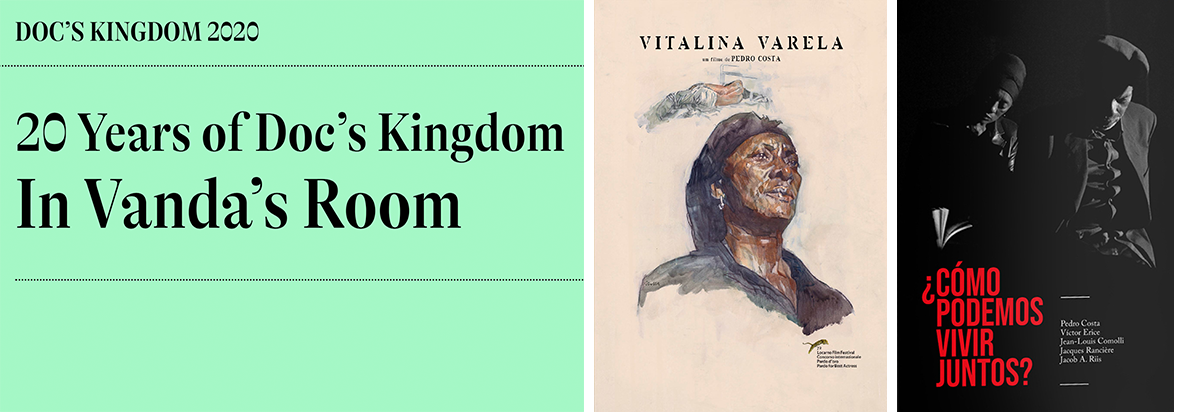
One of the guests of this year's tenth edition of ‘Encontros Cinematográficos’ was Pedro Costa. Doc's Kingdom, that other annual imaginative gathering in Portugal, in this case in Arcos de Valdevez, celebrated its 20th anniversary. On this occasion, the seminal discussion on Pedro Costa's In Vanda's Room at the very first Doc’s Kingdom seminar in October 2000 has now been translated to English. This discussion was initiated by Thierry Lounas and Emmanuel Burdeau. You can find the PDF of the translation and a new text on the film, written by Chris Fujiwara, on the website of Doc's Kingdom, the international seminar on documentary film.
The new Midas Filmes DVD/Blu-ray edition of Pedro Costa's most recent film, Vitalina Varela, contains a 72-page photo booklet of the shoot, not included in the Second Run or Grasshopper editions that offer shorter booklets with essays by Daniel Kasman and Jonathan Rosenbaum, respectively. Critic and programmer Andy Rector describes the photo booklet as “an absolute beauty in itself, like one large engraving of the various planes of the work, the long haul of the shoot, the neighborhood's resilience, and more precious moments with Ventura and Vitalina, in-between and during the takes. It's a pure dedication to the craft, the people, and the cinema.” You can find more information and order this edition on the website of the label.
The Spanish distributor NUMAX presents a joint edition of the blu-ray and DVD of Vitalina Varela and Cavalo dinheiro (2004), limited to 500 items, and including a 128-page book with an unpublished text by Pedro Costa, “¿Cómo podemos vivir juntos?” ("How can we live together?”), based on his speech at Cinema NUMAX in Santiago de Compostela in September 2016. Other texts in the booklet, translated for the first time to Spanish, are two pieces, originally published in Trafic on Cavalo dinheiro and Vitalina Varela, respectively: Jean-Louis Comolli's “Nuits sans jour et jours sans nuit” and Jacques Rancière's “Deux yeux dans la nuit”. You can read a English and Dutch translation of the latter text on Sabzian. The book also contains “Pedro Costa” by Víctor Erice, “Vitalina Varela: The facts” by Pedro Costa, dialogues from both films, and 12 photographs of Jacob Riis provided by the Museum of the City of New York that inspired Cavalo dinheiro. You can find more information on the page of NUMAX's crowdfunding campaign thas has reached its goal on January 8.
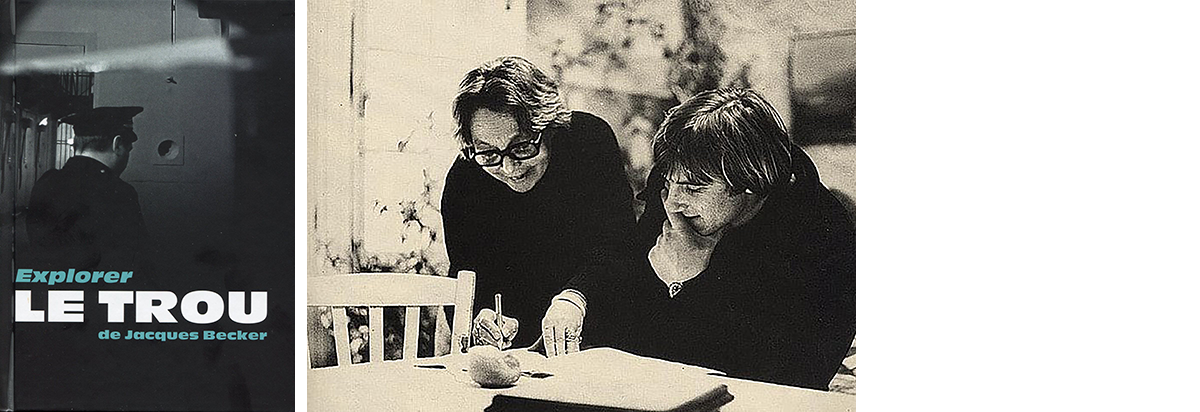
While talking about substantial dvd or blu-ray booklets, the Studiocanal blu-ray edition of Le Trou (Jacques Becker, 1960) includes a 180-page book, Explorer 'Le Trou' de Jacques Becker, with texts by Jean-Baptiste Thoret, Antoine de Baecque, Bernard Benoniel and Olivier Père. The second part of the publication offers archival documents, reviews and interviews, and it concludes with the first 32 pages of the orginal film script, including the minutes that were cut by the producer right after the release. You can find all the other extras and order this edition on the website of the label.
Gaumont releases Marguerite Duras's Le camion (1977) on DVD and blu-ray on February 17. It's available for pre-order in the boutique of Gaumont on Fnac. There it says the edition won't have English subtitles, while another site indicates it will. Coincidentally, the script for Le camion comes out in an English translation on April 4. It will be part of The Darkroom, a book that will also contain four manifesto-like propositions in which Duras protests that most movies “beat the imagination to death”. In the interview with Michelle Porte that follows, Duras further describes her filmmaking style, discussing everything from her biography to her deconstruction of Marxism. The introduction has been written by philosopher Jean-Luc Nancy specifically for this publication. You'll be able to order it on the website of Contra Mundum Press, where you can find more information.
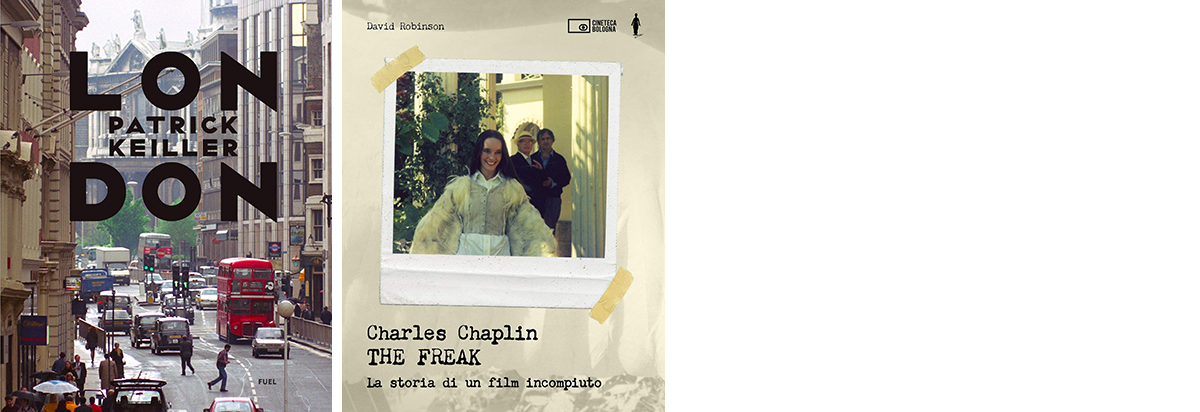
Two other, special film scripts have recently been published in book form. One is that of Patrick Keiller’s unique essay film London (1994), a highly imaginative psychogeographic journey through (and history of) the city. With an afterword and location notes from the director, the book’s publication is the first time the film has been fully reproduced in print, presented as a series of stills alongside its entire dialogue. You can order the book on the website of Fuel Publishing.
Another more recently issued screenplay is that of Charlie Chaplin's unfinished film The Freak. It's part of a book by Italy's Cineteca di Bologna that for the first time unearths the full and final version of this script, a passion project about a young woman with wings that Chaplin left when he passed away in 1977. The book also comprises previously unseen materials, such as preparatory notes, drawings, photos and stills from filmed rehearsals of the film that Bologna archives chief Gianluca Farinelli calls Chaplin’s “artistic testament”. Chaplin conceived and developed the idea for the film in 1968-69 when he was almost 80, and at his own cost he already hired designers to produce storyboards and explore solutions for the necessary pre-CGI effects. Bologna's Cecilia Cenciarelli, who has been working with the Chaplin Archive for years, found the fascinating materials of The Freak (almost 3000 pages, including sound recordings of Chaplin's reading of the script and his piano experiments for the score) among the recently acquiered papers of Chaplin producer Jerry Epstein. Assembling the book, she worked in close collaboration with Chaplin's daughter Victoria, who was meant to star as the young lead then, and who now provides insights and a personal testimony on the project in a conversation chapter. The book also features a commentary by British critic and Chaplin biographer David Robinson. Ten years in the making, the book is being published in Italian before being presented to international publishers. Charles Chaplin - The Freak: La storia di un film incompiuto can be ordered in the Cineteca's online shop.
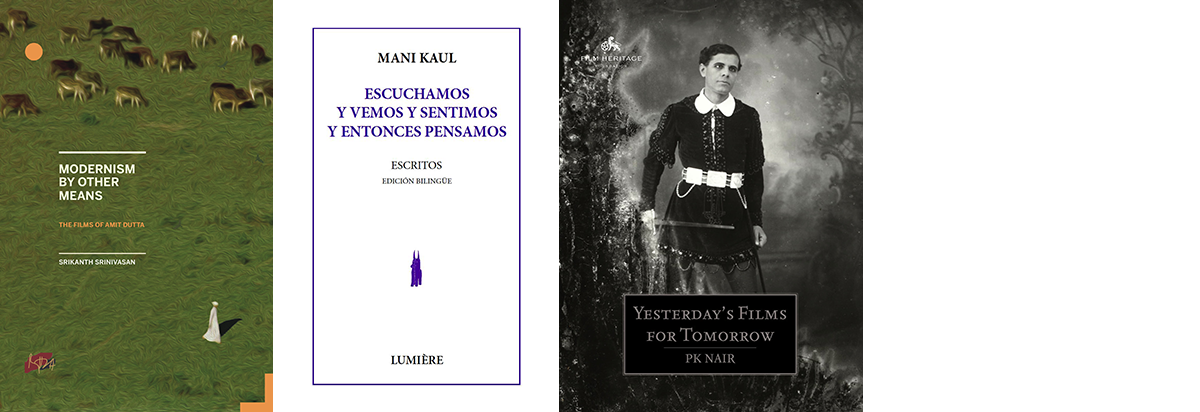
Granting the usual digressions, the next cluster of publications will be mainly devoted to experimental cinema, for lack of a better term. Modernism by Other Means is the first book-length consideration of the work of Indian experimental filmmaker Amit Dutta, written by a regular in these round-ups, Bangalore-based critic Srikanth Srinivasan. Despite universal acclaim, including awards and retrospectives across the world, critical commentary on Dutta's unclassifiable, sensual and stimulating cinema of aesthetic introspection has remained scarce. Through close-grained critical analysis of each of his films, this study examines how Dutta’s work strives towards an authentic, non-Eurocentric conception of modernism, inviting us to reframe our ideas of what being modern in art means. Nicole Brenez has called it “a magnificent work, as complete as it is precise, analyzing in depth each of Amit Dutta’s films, intended to be a reference.” This volume is published independently with modest means and can use your support. You can order the book on the website of Lightcube, which has recently expanded its publishing activities. The publication is available as Kindle e-book and PDF. They aim for a paperback version this year. You can read excerpts from some of the 19 chapters on MUBI Notebook, Firstpost, and the Indian Cultural Forum. On his website, the author translated the article “In the Ship of Amit Dutta” [“Amit Dutta dans son vaisseau”] by critic and filmmaker Pascale Bodet, originally published in Trafic 95 (September 2015). The indefatigable and beneficent Srinivasan also just finished his translation of Luc Moullet's monograph Fritz Lang (1963/70, Seghers)!
Lumière made a compilation of the writings of another Indian filmmaker who was teaching in the Film and Television Institute of India (FTII) around the same time Amit Dutta was a student there and is one of the chief influences on his films, Mani Kaul. As Srikanth Srinivasan writes in his book, “both Kaul’s and Dutta’s films dispense with conventional realist exposition and, instead, look deeper into their respective subjects’ life and work for formal inspiration.They both find their shape through close attention to indigenous forms,” be it Hindustani music or Pahari miniatures. Lumière's publication is a bilingual edition, in Spanish and English, which includes eight of Mani Kaul's texts, his aphorisms and the poems he himself compiled, and are unreleased so far. Coming out this month, this edition will be published in conjunction with the Mani Kaul cycle at the Filmoteca de Catalunya and XCENTRIC CINEMA. We Hear and See and Feel and Then Think: Writings will be available on the website of its publisher Lumière. Revista Lumière had already published Spanish translations of various texts and interviews that were previously gathered in the booklet The Rambling Figures of Mani Kaul", published on the occasion of the Mani Kaul program at the 2018 Courtisane Festival in Ghent.
Taken on as one of the first teachers at the FTII one year after its opening in 1960, P.K. Nair has influenced generations of Indian film students especially the Indian New Wave filmmakers such as Mani Kaul, who graduated there in 1966. Amit Dutta, as well, recalls how “around 1997 or 1998, I traveled for twelve hours overnight to Delhi and joined a small film appreciation course conducted by P. K. Nair, [where] I saw many films on an old 16mm projector, including those of Ritwik Ghatak, Satyajit Ray, and, for the very first time, Robert Bresson, and I returned home with a whole new inner world.” The Film Heritage Foundation of India announced that Yesterday’s Films For Tomorrow, their 2017 compilation that for the first time brought together the writings of P.K. Nair (1933-2016), is available again, as it had become hard to find a copy. Founder of India's National Film Archive in Pune, P.K. Nair was a legendary film archivist, to be ranked with Henri Langlois in France, but also wrote extensively. All proceeds from the sale of the book will go towards supporting the Film Heritage Foundation's activities. Please write to contact@filmheritagefoundation.co.in to purchase a copy of the book.
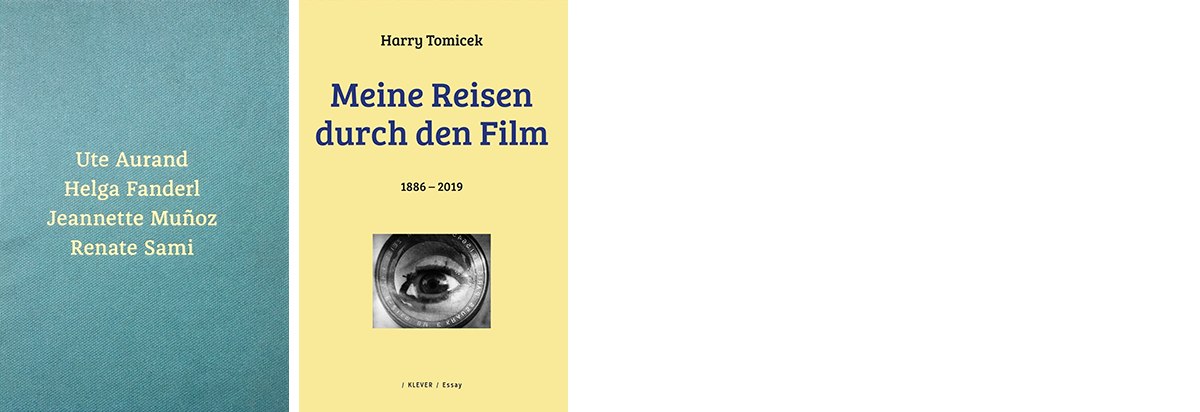
Lumière's Francisco Algarín Navarro, who realized the Mani Kaul publication together with Carlos Saldaña, is also one of the contributors to Meditations on the Present: Ute Aurand, Helga Fanderl, Jeannette Muñoz and Renate Sami. This is the first book to explore the connections between the distinctive oeuvres of these four German and Chilean filmmakers who over the years have built an informal community through cinema. Working in the avant-garde, experimental film tradition, this constellation of intergenerational collaborators is portrayed through their own reflections as well as through essays about their work, their mutual friendships, and influences. Edited by María Palacios Cruz and the festival's artistic director Garbiñe Ortega, this trilingual edition (English/Spanish/Euskera) is a publication of the international documentary film festival Punto de Vista in Pamplona, Spain and available to order through the shop of the National Gallery of Art in Washington since October (after it came out during the first wave of lockdowns without a festive book launch).
One of the contributors to the latter book, the American experimental filmmaker Robert Beavers, is with his own work one of the subjects in Meine Reisen durch den Film 1895 – 2020 by Harry Tomicek, writer for the programs of the Austrian Film Museum. In his newsletter, Beavers calls it “an articulate and personal anthology of film essays. Tomicek’s response to Anger, Baillie, Brakhage, Friedl Kubelka, Markopoulos, Mekas, Snow, and my own films articulates the basic existential position of the filmmaker.” This collection, spanning four decades and almost 600 pages, doesn't only deal with avant-garde filmmakers, but also more classic auteurs, such as Buñuel, Dreyer, Welles, Feuillade, Renoir, Melville, Bresson, Visconti, Fellini, Hitchcock, Ford, Ozu, Kurosawa, Mizoguchi, Naruse, Hou Hsiao-Hsien, Robert Flaherty, or Jerry Lewis and James Stewart. You can order this German-language publication on the website of the Vienna-based Klever Verlag. You can read Patrick Holzapfel's appreciation of Tomicek and the book on the website of the German Filmdienst.
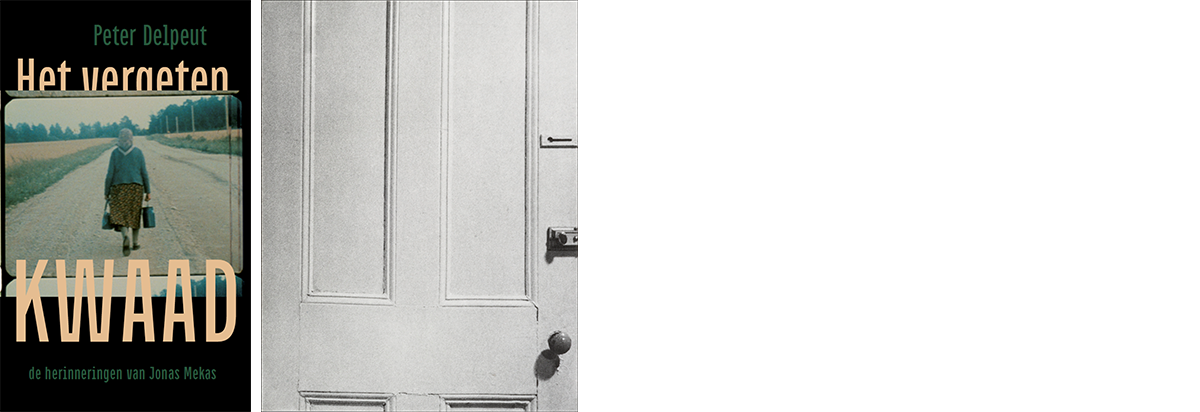
On the occasion of the latter book launch, Robert Beavers recalled in his newsletter Jonas Mekas’s observation: “it’s the politicians and the social workers, all the so-called socially concerned citizens who are asking for ‘justice’: they are still practicing the law of ‘an eye for an eye’. The artist is the one who practices the politics of gods and gives it all without asking anything in return.” In April, the Dutch author and filmmaker Peter Delpeut comes with a new book on Jonas Mekas for whom he carries a lifelong admiration. Het vergeten kwaad: De herinneringen van Jonas Mekas [The forgotten evil: The memories of Jonas Mekas] investigates the claim of historian Michael Casper, put forward in The New York Review of Books of June 2018, that Mekas knowingly forgot or misrepresented certain events that happened in Lithuania during Word War II, the country he fled for the States in 1949. Delpeut's research resulted in a personal essay on historiography versus individual memory, in which he did not want to go easy on Mekas, Casper or himself. You can already reserve a copy of this Dutch-language publication on the website of publisher Atlas Contact.
One of the filmmakers championed by Jonas Mekas and for a time part of the underground film scene centered around his Filmmakers' Cinematheque, Canadian artist Michael Snow, has been celebrated with the reissue of his most renowned photo book. For years an out-of-print rarity, Michael Snow’s classic 1975 artist's book Cover to Cover is available once again in a facsimile edition. Composed entirely of photographs in narrative sequence and structured around a precise recto-verso montage, the book has been described by Snow himself as “a quasi-movie”. You can order one of the only 2500 copies on the website of the publishers, Light Industry and Primary Information, where you can also find the reviews from Cinema Scope, Brooklyn Rail and Artnews. Here, you can flip through Cover to Cover.
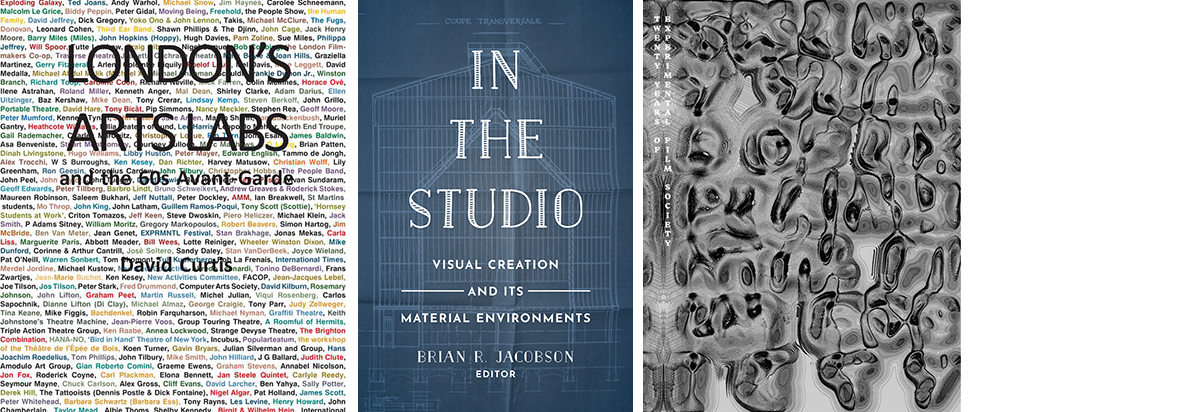
London's Arts Labs and the 60s Avant-Garde tells the story of two short-lived UK artist-run spaces: the Drury Lane Arts Lab (1967–69) and the Robert Street New Arts Lab (1969–71). The former was home to the first UK screenings of Andy Warhol's twin-screen 3 hour film Chelsea Girls, challenging exhibitions (e.g. John and Yoko's first joint show), poetry and music (e.g. the first UK performance of Erik Satie's 24-hour Vexations) and fringe theatre. The latter housed Britain's first video workshop TVX, the London Filmmakers Co-op's first workshop, a 5-days-a-week cinema devoted to showing new work by moving-image artists (e.g. Sally Potter, Carolee Schneemann and Peter Gidal), and staged J. G. Ballard's infamous Crashed Cars exhibition. Both spaces are associated with some of the most innovative developments in the arts in Britain in the late 1960s. Their impact led to an explosion of new artist-led spaces across the country. This is “a memoir of sorts” by David Curtis, who was involved with both labs, was in charge of the grants for filmmaking artists for over twenty years and has written extensively on experimental film. Here, you can find the table of contents and order this publication by John Libbey Publishing.
The next book also focusses on specific sites of artistic creation and physical labor. Don't be fooled by its dusty title and cover, In the Studio: Visual Creation and Its Material Environments is an unique collection about the experimental workplaces of filmmakers and artists from Aleksandr Medvedkin's Kino-Train to the Eames Office and Hollis Frampton's Digital Arts Lab, but just as well about iconic film studios, such as Pinewood, Cinecittà, Lucasfilm, Mexico City's Churubusco, and the CBS Studios in L.A. Studios have faded into the background of critical discourse and into the margins of film and media history. In response, In the Studio demonstrates that when we foreground these “worlds built to build worlds”, we gain new insights into moving-image culture and the dynamics that quietly mark the worlds on our screens. Film scholar Richard Abel has called it "a major contribution to the recent scholarly interest in the production studio as a neglected subject of film and media studies”. New York's Light Industry devoted a podcast to this “remarkable new anthology”. You can read an excerpt, find the table of contens and order the book on the website of University of California Press.
Luminous Void: Twenty Years of Experimental Film Society is another anthology that marks the twentieth anniversary of the Experimental Film Society, an Irish-based organisation for the production, archiving and distribution of personal, formally radical cinema. It was founded by Rouzbeh Rashidi, who edited this collection together with fellow EFS filmmakers Maximilian Le Cain and Atoosa Pour Hosseini. The volume celebrates the prolific work and achievements of this unlikely group of creative outsiders who, similar to the more loosely connected filmmakers in the above-mentioned Meditations on the Present, banded together. The publication includes contributions by international critics and curators, such as Nadin Mai, Vahid Mortazavi, and Adrian Martin who gave a talk as special guest speaker at the book launch last December. To order the book, please use the ‘Buy Now’ button on the website of the Experimental Film Society.
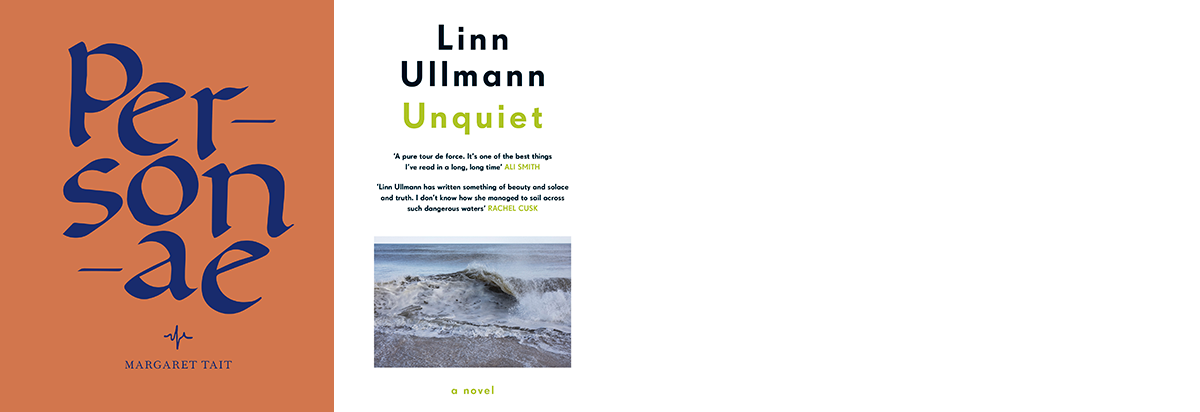
The next two books both move between the genres of the memoir, novel and autobiography. Last December, LUX released Personae, an unpublished book by Scottish filmmaker and poet Margaret Tait. Personae is her unpublished manuscript written over a number of years from 1945 onwards and painstakingly reconstructed by Sarah Neely from drafts found in the Tait archive. It is an undefinable work, part-memoir, part-experimental non-fiction, a meditation on the aftermath of war, the healing potential of the creative process and an attempt to think towards a future born out of chaos. The book also offers a unique insight into the voice, mind and creative process of this singular artist. You can order the book on the website of LUX, where you can also find Peter Todd's specially comissioned essay about Tait and a ‘tour’ about her life and work made by the Scottish author Ali Smith who also wrote the foreword to Personae.
It was also Ali Smith who's called the next book “one of the best things [she's] read in a long, long time.” Unquiet is Linn Ullmann’s novel/memoir about growing up as the daughter of Ingmar Bergman and actress Liv Ullmann. Herself an award-winning and widely translated author, Linn Ullmann reflects on six taped conversations she had with her father at the very end of his life. The book follows the narrator as she unearths these taped conversations seven years later. Swept into memory, she reimagines the story of a father, a mother, and a girl – a child who can’t wait to grow up and parents who would rather be children. Unquiet is an elegy of memory and loss, identity and art, growing up and growing old. Ullmann nimbly blends memoir and fiction in a most inventive novel, weaving a luminous meditation on language, mourning, and the many narratives that make up a life. Praised by fellow authors Siri Hustvedt and Rachel Cusk, Unquiet was included in Sight & Sound's list of the ten best film books of 2020. You can order the English translation of Ullmann's De urolige (Forlaget Oktober, 2015) on the website of its publisher in the U.S., W. W. Norton, or the U.K., Hamish Hamilton (now part of Pinguin Books). The novel had already been translated to Dutch as De Rustelozen (Hollands Diep, 2016).
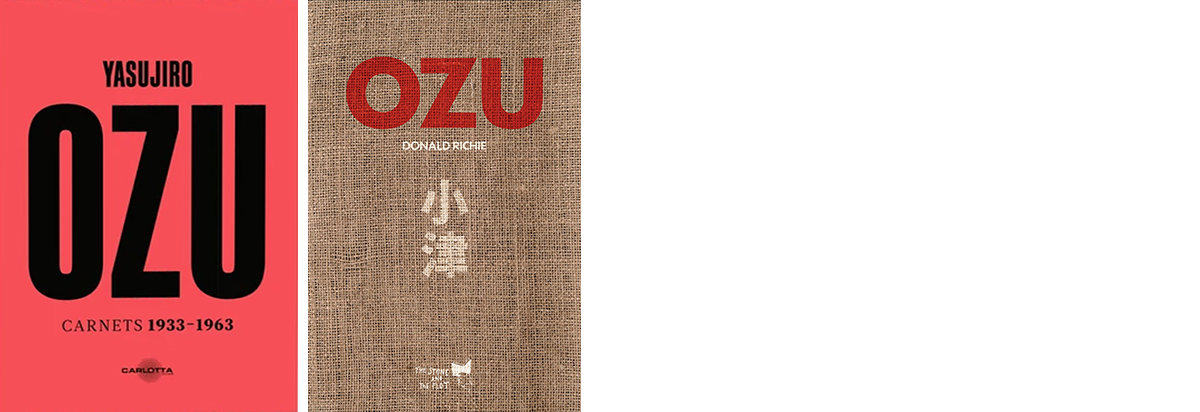
Another intimate account, Yasujiro Ozu's diaries have been reissued after being out of print for nearly 20 years. Yasujiro Ozu: Carnets 1933-1963 covers thirty years of the filmmaker's life through the daily journal he kept all his life. Between laconic notations, poetic inspiration, expression of his emotions and often sarcastic thoughts, the 32 notebooks reveal an ordinary being of flesh and blood of rare sensitivity and intelligence. Chronicling his day-to-day activities, often in a concise manner, sometimes by enriching it with haikus, Ozu recorded the weather, food, family, friends, the drinking evenings, baseball season, bereavements, the war, illness, the throes of writing and directing, films and the shows he sees. This volume offers a complete translation (1262 pages), revised and enlarged from the original French edition published in 1996 by Editions Alive. The preface, written at the time by filmmaker Alain Corneau, has been preserved. You can order this publication on the website of Carlotta, where you can also listen to an excerpt read by the translator Josiane Pinon-Kawataké. An English version has been long overdue.
Dimanche 12 janvier 1958
Tout le jour à la maison; n'ai rien fait.
In a short text about these diaries on the Criterion website, Ozu expert Donald Richie notes that “in [his diary] he pays as much attention to what he eats as to the film at hand. (...) On August 31, 1934, he and fellow director Mikio Naruse enjoyed Scarface and then talked about it while having pork cutlets. A year later, he goes alone to see Frank Capra’s It Happened One Night, which he calls “a really successful comedy.” For our Portuguese readers, a quick note that Richie's seminal study on the filmmaker, Ozu: His Life and Films (University of California Press, 1974), has just been translated to Portuguese. The book has been released by Daniel Pereira's young publishing, production and distribution company, The Stone and the Plot, that also put out the above-mentioned Encontros Cinematográficos. Partly realized thanks to a successful crowdfunding campaign, the publication is available in the bookshop of the Cinemateca Portuguesa, Linha de Sombra.
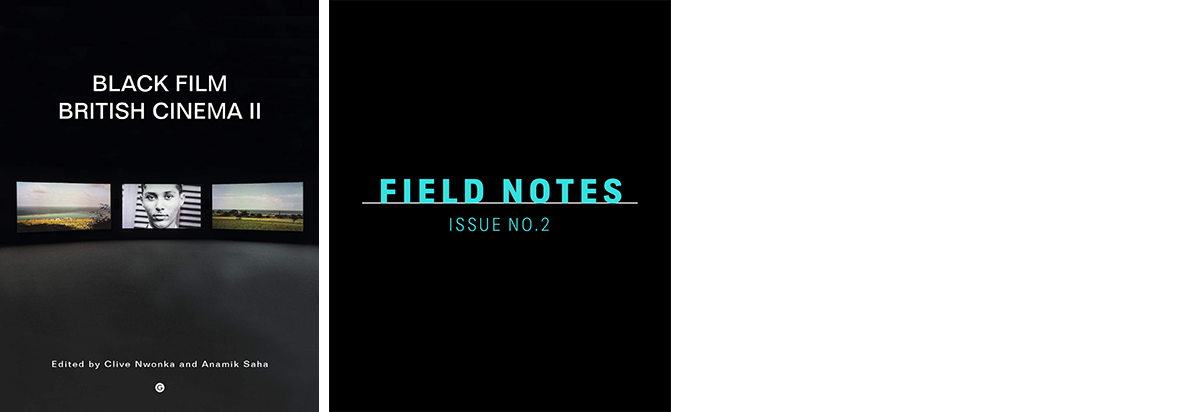
Forthcoming in March, Black Film British Cinema II considers the politics of race in British screen culture over the last thirty years, addressing the institutional, textual, cultural, and political shifts that have occurred during this period. This edited collection of essays offers a diverse range of responses from practitioners and scholars, such as So Mayer and many others. Published by Goldsmiths Press, the book's available for pre-order and distributed through the website of the MIT Press.
One of the contributors to the latter volume – curatorial director at the Criterion Collection and former BAM programmer, Ashley Clark – is also a regular columnist for the new online journal Field Notes. Established last September, Field Notes is devoted to original writing on nonfiction filmmaking in all its forms. They've already launched their second issue at the end of December. The journal's put out by the New York-based, filmmaker-driven, documentary production unit, Field of Vision.
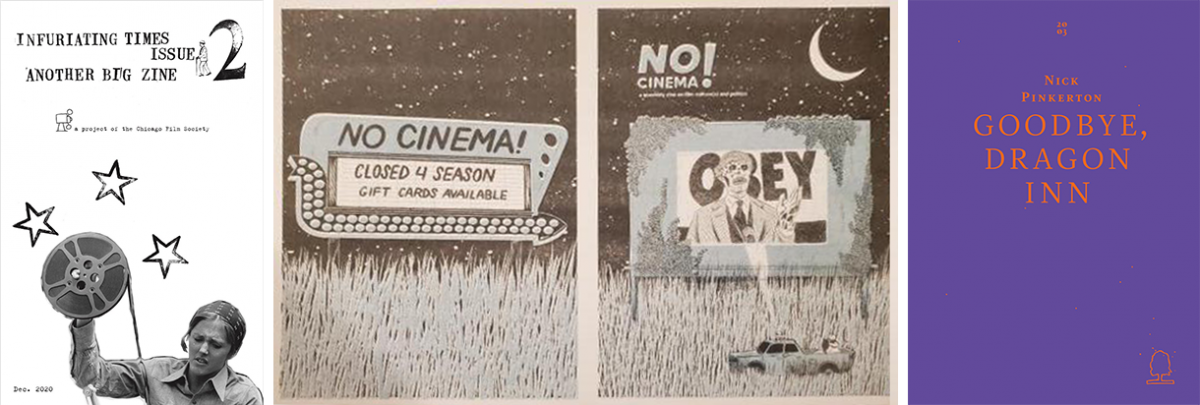
The foundation of Field Notes brings us to a small round-up of newly established film magazines. Unfortunately, two journals also announced that the publication will be on an indefinite hiatus: the Swedish biannual magazine Walden (°2012) with its last issue 19/20, and the Flemish monthly print publication, Filmmagie, that would have celebrated its 65th anniversary this month as one of the longest running independent film magazines in the world. Over the past couple of months, two new Chicago-based film zines took form. While screenings are postponed, the programmers and projectionists of the Chicago Film Society have launched a zine called Infuriating Times. After the inaugural issue last September, a second number appeared at the beginning of January. Each of them opens with the outspoken ‘Notes on the current state of cinema’. Support CFS on Patreon to receive the latest issue or purchase single copies here. Back issues are available in limited quantities. This month, the first issue of NO CINEMA!, a new quarterly zine on film culture(s) and politics, will be mailed out in two-color risograph printed, hand-bound copies to the subscribers on their patreon. The project wants to bring “alternative perspectives responsive to the degeneration of film culture under capitalism, its resultant contradictions, and the realities of reproducing film cultures (watching movies, posting, etc.) in a 21st century in which the geography of physical film cultures is less central and the formerly de-centered virtual spaces have been co-opted by old traditionalists and commercial interest with rare exception.” They aim “to produce a collection of materials which better reflects the experiences of people systematically separated from regular channels of film cultural production.” For a second issue, the call remains open to contributors “who feel passionate but disconnected from prevailing centers of cultural (re)production.” Here, you can find the table of contents of issue #1.
The people behind Fireflies magazine, which is being issued since 2014, have now branched out into book publishing, founding Fireflies Press. With the Decadent Editions, they'll put out a series of 10 books about 10 films, one for every year of the 2000s. Starting in March 2021 with the launch of Nick Pinkerton’s book on Goodbye, Dragon Inn (Tsai Ming-liang, 2003), a new Decadent Editions title will be released at regular intervals. Upcoming titles include Erika Balsom on Ten Skies (James Benning, 2004), Dennis Lim on Tale of Cinema (Hong Sang-soo, 2005), Melissa Anderson on Inland Empire (David Lynch, 2006) and Rebecca Harkins-Cross on The Headless Woman (Lucrecia Martel, 2008). On the website of Fireflies Press, you can pre-order Goodbye, Dragon Inn or subscribe to the first five titles. Fireflies Press is also working on a chronicle of the genesis and creation of Memoria, the new film by Apichatpong Weerasethakul.
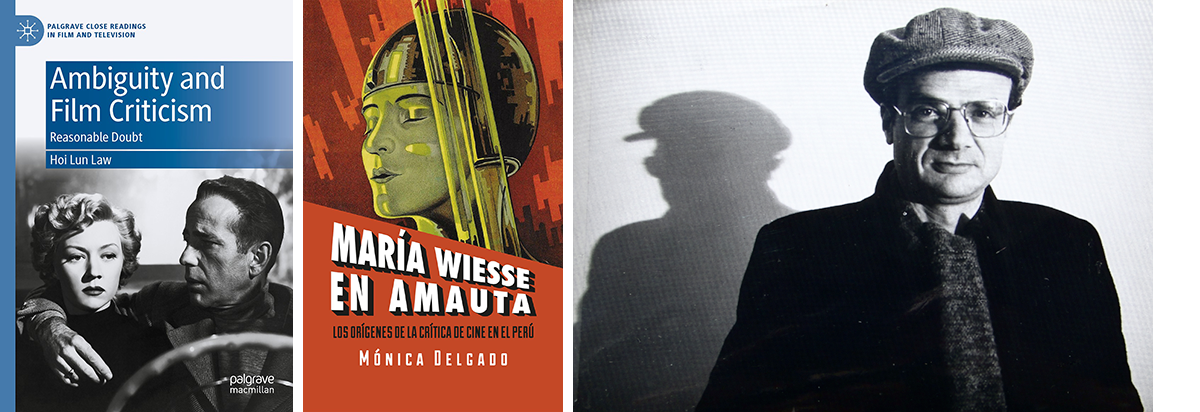
This leads us to a final set of three books that explicitly deal with film criticism. Forthcoming on February 26, Ambiguity and Film Criticism: Reasonable Doubt aims to rethink the operation of film criticism through the concept of ambiguity, that what presses us to inquire into our puzzlement over a film, to persistently ask “why is it as it is?” Adrian Martin calls it “a highly significant and original book,” that “brings a razor-sharp eye, ear and mind to the question of ambiguity in cinema, and how film criticism can best discern and explore it.” You can pre-order the book on the website of Palgrave Macmillan.
Mónica Delgado, one of the directors of the online film magazine Desistfilm, has a new book out, María Wiesse en Amauta: los orígenes de la crítica de cine en el Perú. Although the cover with Metropolis's Maria can create confusion, the book is an investigation of a pioneer of film criticism in Peru, María Wiesse, who, to this day, had not been recognized as such. Not only a critic but also a poet and essayist, Wiesse's output of texts on cinema was most constant and continuous for the short-lived Amauta magazine. One of the most influential journals of the 20th century, Amauta (1926-30) was a Marxist, avant-garde magazine that gathered art, poetry, literature, and political thought from international collaborators including Jorge Luis Borges, André Breton, Sigmund Freud, George Grosz, Pablo Neruda, Diego Rivera and dozens of other key cultural figures in Latin America, Europe, and the United States. From a detailed analysis of Wiesse's writings, Delgado approaches the critical gaze of a woman who constantly reflects on her time, the emergence of the modern, and the social role of cinema. The book also includes the complete list of all the texts she wrote for Amauta and the facsimiles of these. You can find the table of contents and order this Spanish-language publication on the website of the Peruvian publishing house Gafas Moradas.
Let's conclude with something to really look forward to. Laurent Kretzschmar of the ‘Serge Daney in English’ website, signaled that an English translation (of the first volume?) of the collected texts of the French critic Serge Daney, La Maison cinéma et le monde (P.O.L, vol. 1-4, 2001-2015), seems to be happening. Apparently the Los Angeles-based, independent publisher, Semiotext(e), long known for its translations of French critical theory, already acquired the rights in 2013. P.O.L indeed lists Semiotext(e) as the translator for the US, but only on the page of the first volume, ‘the time of Cahiers’ (1962-1981). In an interview, Hedi El Kholti, editor of Semiotext(e), offhandedly announced: “It went through a few translators, who started the project but felt overwhelmed by the scope and commitment and gave up. It’s finally coming out next year [2021], or in early 2022.”

